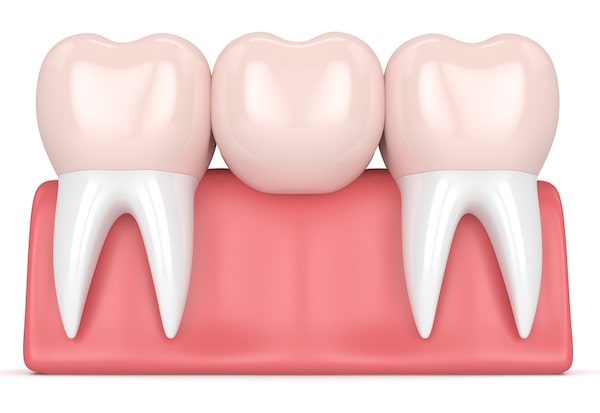A dental bridge utilizes a fixed prosthetic device to address teeth that are missing in the mouth. It is called a dental bridge because it bridges a gap between missing teeth. The procedure uses the adjacent teeth to support the bridge that is placed in-between the natural teeth. Dental bridges are made of several types of materials to match the shape, size, color, and texture of the natural teeth. This cosmetic dentistry procedure benefits a patient’s oral health, restores functionality such as the ability to speak properly or chewing and it also improves a patient’s smile.
Dental Bridge Procedure
 A traditional dental bridge is a multi-step process which means the patient will need more than one office visit. A local anesthetic is injected into the gum tissue of the adjacent healthy teeth and the dentist reshapes the supporting teeth, referred to as abutments, by filing them down. The dentist makes an impression of the mouth that is sent to a laboratory to create a customized bridge that fits the patient’s mouth.
A traditional dental bridge is a multi-step process which means the patient will need more than one office visit. A local anesthetic is injected into the gum tissue of the adjacent healthy teeth and the dentist reshapes the supporting teeth, referred to as abutments, by filing them down. The dentist makes an impression of the mouth that is sent to a laboratory to create a customized bridge that fits the patient’s mouth.
While waiting for the permanent dental bridge, the dentist will place a temporary bridge to fill the space and protect the newly formed abutments. When the permanent bridge arrives from the lab, the patient will be fitted for the bridge. The dentist tests the bridge for bite alignment and makes any necessary adjustments before securing it into place in the mouth.
Alternative types of dental bridges include:
- A cantilever bridge is a procedure where a single crown supports the entire restoration (which usually consists of two pontics)
- A Maryland bridge replaces a single missing tooth and consists of attaching a pontic with two small wings on the back of the supporting teeth.
- An implant-supported bridge is when a titanium post is placed in the jawbone and an abutment secures a custom-made restoration to the post
Dental Bridge Recovery and Results
The recovery time after a dental bridge is placed in the mouth is minor. The anesthetic can cause the mouth to feel numb after the treatment. After that, the patient might feel some discomfort in the gum area where the bridge is cemented to the tooth. This discomfort will subside within a few days. The abutment teeth may feel sensitive for the first few weeks to months, and this can be managed by avoiding extremely hot or cold foods and beverages. It can take some time to get used to the new bridge when eating so patients should consume soft foods at first and avoid hard foods or chewy foods.
The results are noticeable immediately after the dentist cements the crown to the abutment teeth. The dental bridge will improve bite balance, speech difficulties and the ability to chew properly. When properly cared for, dental bridges can last 10 to 15 years or more. Patients should not use their teeth to open packages or chew ice or hard foods as they could break or chip their restoration. Patients will need to brush their teeth twice a day and floss daily.
Dental Bridge – Limitations for Patients
The limitation of having a dental bridge includes the fact that they cannot be placed on decayed or weakened teeth. Patients with gum disease or an oral infection cannot have the treatment until their symptoms are treated. Patients who are missing three, or more, consecutive teeth might be better suited for a fixed or removable partial denture.
Dental Bridge Risks:
- Allergic reaction to the anesthetic or restorative material
- Tooth sensitivity
- Increased risk of decay in the abutment teeth
- Collapsed bridge due to tooth weakening
- Chipped, cracked, or broken restoration
- The need for a bridge replacement at some point in the future
A dental bridge is a popular cosmetic dentistry option as it can restore functionality of a missing tooth and also improve the smile of a patient. The long-lasting success of a dental bridge depends on a number of factors such as the skills and experience of the dentist and the ongoing oral care practiced by the patient.
The porcelain that is used to create a dental bridge is extraordinarily strong, but it can possibly chip or fracture if it is improperly maintained by the patient. Some of the reasons a dental bridge can be damaged include eating hard foods or ice and the practice of poor oral hygiene. These habits can void the placement of a successful dental bridge by weakening the porcelain or the abutment teeth. Proper oral care helps maintain beautiful teeth and protects the dental bridge for many years.
Patients who are not sure about the proper steps to follow to maintain their dental bridge should consult with the dentist who placed the bridge in the mouth. The dentist can provide advice and input on the proper way to maintain the teeth and also help a person by showing examples of other patients that followed the steps necessary to maintain their dental bridge.






